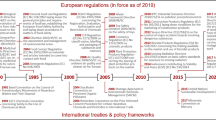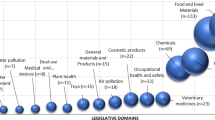Abstract
“COSHH essentials” was developed in Great Britain to help duty holders comply with the Control of Substances Hazardous to Health (COSHH) Regulations. It uses a similar approach to that described in the new European “REACH” Regulation (Registration, Evaluation, Authorisation and Restriction of Chemicals; EC No. 1907/2006 of the European Parliament), insofar as it identifies measures for managing the risk for specified exposure scenarios. It can therefore assist REACH duty holders with the identification and communication of appropriate risk-management measures. The technical basis for COSHH essentials is explained in the original papers published in the Annals of Occupational Hygiene. Its details will, therefore, not be described here; rather, its ability to provide a suitable means for communicating risk-management measures will be explored. COSHH essentials is a simple tool based on an empirical approach to risk assessment and risk management. The output is a “Control Guidance Sheet” that lists the “dos” and “don'ts” for control in a specific task scenario. The guidance in COSHH essentials recognises that exposure in the workplace will depend not just on mechanical controls, but also on a number of other factors, including administrative and behavioural controls, such as systems of work, supervision and training. In 2002, COSHH essentials was made freely available via the internet (http://www.coshh-essentials.org.uk/). This electronic delivery enabled links to be made between product series that share tasks, such as drum filling, and with ancillary guidance, such as setting up health surveillance for work with a respiratory sensitiser. COSHH essentials has proved to be a popular tool for communicating good control practice. It has attracted over 1 million visits to its site since its launch. It offers a common benchmark of good practice for chemical users, manufacturers, suppliers and importers, as well as regulators and health professionals.
This is a preview of subscription content, access via your institution
Access options
Subscribe to this journal
Receive 6 print issues and online access
$259.00 per year
only $43.17 per issue
Buy this article
- Purchase on Springer Link
- Instant access to full article PDF
Prices may be subject to local taxes which are calculated during checkout
Similar content being viewed by others
References
Brooke I.M. A UK scheme to help small firms control risks to health from exposure to chemicals: toxicological considerations. Ann Occup Hyg 1998: 42 (6): 377–390.
Chambers H., Weyman A., and Keen C. Identification of reasons for failure of control strategies. HSL report 2002 FSSU/02/02.
Cummings R., Waheed F., Corbett E., Marlow P., and Williamson J. e-COSHH essentials guidance sheets: user consultation exercise Phase III. HSL Report 2005 SOFS/05/04.
Evans P.G., and Garrod A.N.I. Letter to the editor. Ann Occup Hyg 2006: 50: 641.
Ferguson E., Bibby P.A., Leaviss J., and Weyman A. Effective Design of Workplace Risk Communications. Publisher: The University of Nottingham and the Health and Safety Laboratory, Derbyshire, UK, 2003, Research Report 093. ISBN 0 7176 2175 8.
Health Safety Executive. Control of Substances Hazardous to Health (fifth edition). The Control of Substances Hazardous to Health Regulations 2002 (as amended). Publisher: HSE Books, Suffolk, UK, 2005, ISBN 0 7176 2981 3.
Health Safety Executive. COSHH Essentials: Easy steps to Control Chemicals. HSG193. Publisher: HSE Books, Suffolk, UK, 1999a, ISBN 0 7176 2421 8.
Health and Safety Executive. Health and Safety in Small Firms. Publisher: HSE Books, Suffolk, UK, 1996 DDE4.
Health Safety Executive. The Technical Basis for COSHH Essentials: Easy Steps to Control Chemicals. HSG 193. Publisher: HSE Books, Suffolk, UK, 1999b, ISBN 0 7176 2434 X.
Maidment S.C. Occupational hygiene considerations in the development of a structure approach to select chemical control strategies. Ann Occup Hyg 1998: 42 (6): 391–400.
Marlow P., Higginson D., and Williamson J. e-COSHH essentials guidance sheets: user consultation exercise Phase II. HSL Report 2004 RAS/04/02.
O'Hara R., Williamson J., Benjamin K., Marlow P., White J., and Wright S. e-COSHH essentials guidance sheets: user consultation exercise. HSL Report 2003 RAS/03/10.
Russell R.M., Maidment S.C., Brooke I.M., and Topping M. An introduction to a UK scheme to help small firms control health risks from chemicals. Ann Occup Hyg 1998: 42 (6): 367–376.
Tischer M., Bredendiek-Kamper S., and Poppek U. Evaluation of the HSE COSHH essentials exposure predictive model on the basis of BAuA field studies and existing substances exposure data. Ann Occup Hyg 2003: 47 (7): 557–569.
Topping M.D., Williams C.R., and Devine J.M. Industry's perception and use of occupational exposure limits. Ann Occup Hyg 1998: 42 (6): 357–366.
Author information
Authors and Affiliations
Corresponding author
Rights and permissions
About this article
Cite this article
Garrod, A., Evans, P. & Davy, C. Risk management measures for chemicals: the “COSHH essentials” approach. J Expo Sci Environ Epidemiol 17 (Suppl 1), S48–S54 (2007). https://doi.org/10.1038/sj.jes.7500585
Received:
Accepted:
Published:
Issue Date:
DOI: https://doi.org/10.1038/sj.jes.7500585
Keywords
This article is cited by
-
Control Banding and the Global Rise of Qualitative Risk Assessment Strategies
Current Environmental Health Reports (2023)



